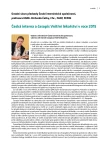Therapeutic monitoring of amikacin and gentamicin in routine clinical practice
Authors:
Ivana Kacířová 1,2; Milan Grundmann 1
Authors‘ workplace:
Ústav klinické farmakologie LF OU Ostrava, přednosta doc. MUDr. Milan Grundmann, CSc.
1; Oddělení klinické farmakologie Ústavu laboratorní diagnostiky FN Ostrava, primářka MUDr. Ivana Kacířová, Ph. D.
2
Published in:
Vnitř Lék 2015; 61(1): 33-41
Category:
Reviews
Overview
Aminoglycosides constitute one of the oldest classes of antimicrobials. Despite their relative toxicity, mainly nephrotoxicity and ototoxicity, aminoglycosides are valuable in current clinical practice. They are bactericidal agents with activity against aerobic gram-negative infections and against gram-positive cocci when added to a cell wall active antimicrobial-based regimen (e.g. betalactams). Aminoglycosides have a concentration-dependent bactericidal effect and a long post antibiotic effect. There is accumulating evidence to show that large, single, daily doses (or more correctly, extended interval dosing) of aminoglycosides is associated with less nephrotoxicity and ototoxicity and comparable, if not superior clinical outcomes than the same total dose administered in small, multiple doses. The efficacy and toxicity of aminoglycosides show a strong direct positive relationship with blood drug concentrations. A key strategy in minimizing toxicity and optimizing therapy is therapeutic drug monitoring.
Key words:
aminoglycosides – amikacin – gentamicin – therapeutic monitoring
Sources
1. Pagkalis S, Mantadakis E, Mavros MN et al. Pharmacological considerations for the proper clinical use of aminoglycosides. Drugs 2011; 71(17): 2277–2294.
2. Radigan EA, Gilchrist NA, Miller MA. Management of aminoglycosides in the intensive care unit. J Intensive Care Med 2010; 25(6): 327–342.
3. Informace dostupné z WWW: <http://www.sukl.cz/>.
4. Shim TS, Jo KW. Medical treatment of pulmonary multidrug-resistant tuberculosis. Infect Chemother 2013; 45(4): 367–374.
5. Wassil SK, Fox KM, White JW. Once Daily Dosing of Aminoglycosides in Pediatric Cystic Fibrosis Patients: A Review of the Literature. J Pediatr Pharmacol Ther 2008; 13(2): 68–75.
6. Hanberger H, Edlund C, Furebring M et al. Rational use of aminoglycosides-review and recommendations by the Swedish Reference Group for Antibiotics (SRGA). Scand J Infect Dis 2013; 45(3): 161–175.
7. Avent ML, Rogers BA, Cheng AC et al. Current use of aminoglycosides: indications, pharmacokinetics and monitoring for toxicity. Intern Med J 2011; 41(6): 441–449.
8. Mahmoudi L, Niknam R, Mousavi S et al. Optimal Aminoglycoside Therapy Following the Sepsis: How Much Is Too Much? Iran J Pharm Res 2013; 12(2): 261–269.
9. Roberts JA, Lipman J. Antibacterial Dosing in Intensive Care Pharmacokinetics, Degree of Disease and Pharmacodynamics of Sepsis. Clin Pharmacokinet 2006; 45(8): 755–773.
10. Moore RD, Lietman PS, Smith CR. Clinical response to aminoglycoside therapy: importance of the ratio of peak concentration to minimal inhibitory concentration. J Infect Dis 1987; 155(1): 93–99.
11. Boyer A, Gruson D, Bouchet S et al. Aminoglycosides in septic shock: an overview, with specific consideration given to their nephrotoxic risk. Drug Saf 2013; 36(4): 217–230.
12. Touw DJ, Westerman EM, Sprij AJ. Therapeutic Drug Monitoring of Aminoglycosides in Neonates. Clin Pharmacokinet 2009; 48(2): 71–88.
13. Van Lent-Evers NA, Mathot RA, Geus WP et al. Impact of goaloriented andmodel-based clinical pharmacokinetic dosing of aminoglycosides on clinical outcome: a cost-effectiveness analysis. Ther Drug Monit 1999; 21(1): 63–73.
14. El Desoky ES, Sheikh AA, Al Hammadi AY. Aminoglycoside and vancomycin serum concentration monitoring and mortality due to neonatal sepsis in Saudi Arabia. J Clin Pharm Ther 2003; 28(6): 479–483.
15. Rybak MJ, Lomaestro BM, Rotschafer JC et al. Vancomycin therapeutic guidelines: a summary of consensus recommendations from the infectious diseases Society of America, the American Society of Health-System Pharmacists, and the Society of Infectious Diseases Pharmacists. Clin Infect Dis 2009; 49(3): 325–327.
16. Roberts JA, Field J, Visser A et al. Using population pharmacokinetics to determine gentamicin dosing during extended daily diafiltration in critically ill patients with acute kidney injury. Antimicrob Agents Chemother 2010; 54(9): 3635–3640.
17. Petejova N, Zahalkova J, Duricova J et al. Gentamicin pharmacokinetics during continuous venovenous hemofiltration in critically ill septic patients. J Chemother 2012; 24(2): 107–112.
18. Petejová N, Martínek A, Zahálková J et al. Vliv kontinuální a intermitentní náhrady renálních funkcí na antibiotickou léčbu u kriticky nemocných v sepsi – praktický pohled na léčbu vankomycinem a gentamicinem. Vnitř Lék 2012; 58(6): 448–454.
19. Stabler SN, Ensom MH. Extended-interval aminoglycoside therapy for adult patients with febrile neutropenia: a systematic review. Can J Hosp Pharm 2011; 64(3): 182–191.
20. McKenzie C. Antibiotic dosing in critical illness. J Antimicrob Chemother 2011; 66(Suppl 2): ii 25–31.
21. Taccone FS, Laterre PF, Spapen H et al. Revisiting the loading dose of amikacin for patients with severe sepsis and septic shock. Crit Care 2010; 14(2): R53. Dostupné z DOI: <http://doi: 10.1186/cc8945>.
22. Habib G, Hoen B, Tornos P et al. Guidelines on the prevention, diagnosis, and treatment of infective endocarditis (new version 2009): the Task Force on the Prevention, Diagnosis, and Treatment of Infective Endocarditis of the European Society of Cardiology (ESC). Endorsed by the European Society of Clinical Microbiology and Infectious Diseases (ESCMID) and the International Society of Chemotherapy (ISC) for Infection and Cancer. Eur Heart J 2009; 30(19): 2369–2413.
Labels
Diabetology Endocrinology Internal medicineArticle was published in
Internal Medicine

2015 Issue 1
Most read in this issue
- Therapeutic monitoring of amikacin and gentamicin in routine clinical practice
- Association between asymptomatic hyperuricaemia and metabolic syndrome in the adolescents
- Tachycardia-induced cardiomyopathy
- The role of the assessment of heavy/light chain pairs of immunoglobulin in monoclonal gammopathies
